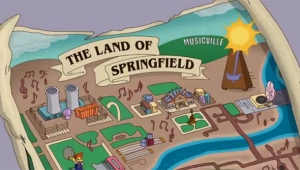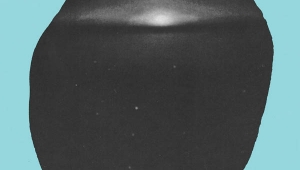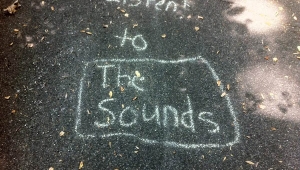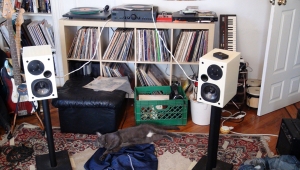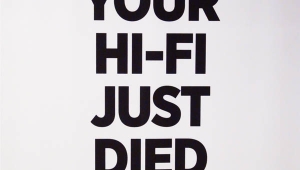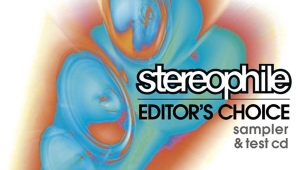| Columns Retired Columns & Blogs |
A Quick Dip in the Digital Stream

Valle del Elqui, Chile. Photo: Alberto Bitran.
For the past few months, my system has been in a serious playback rut. The disc tray on my Oppo DV-980H does not pop out, and my Rega P1 is in unmistakably poor shape: the tonearm cable to connect the tonearm to the cartridge ripped off from the tonearm, one of the tonearm pins ripped off the tonearm cable and is firmly pinned onto the cartridge I never installed (an Audio Technica AT95E), and the needle on my old Ortofon cartridge is bent backwards, which is the reason why I needed to change my cartridge to begin with. I promise, I have reasons for all of this. Not good reasons. Thus, most of my music listening for the past seven months, has been done at work in my cubicle via different digital music streaming services, in the hopes of finding a service that would be fun and functional.
Grooveshark provides music on demand of nearly every single track I could ask for but uses the low-quality MP3 codec, playing at a bit rate of just 128kbps. To play a song, type your desired artist, song, or album in the search query box, and Grooveshark will yield various results, all provided from other users’ uploads onto the Grooveshark server. Nearly all of Grooveshark’s files are sourced from user uploads, accompanied by occasional uploads from sponsoring music labels. Attempting to utilize Grooveshark to its fullest potential, I sequenced entire albums from those artists with whom I wanted to become properly acquainted, including Guns ‘n’ Roses, Sunny Day Real Estate, and Clinic, but the lack of ease in sequencing songs in Grooveshark was exasperating, especially for full albums. To listen to all of Appetite for Destruction, I could click on the album title and select “Play All” —unfortunately, there were three different uploads of Appetite and by selecting Play All, it would sequence all three, causing each track to be repeated three times. In addition, many songs on Grooveshark would cut off halfway through or simply not play at all. In the beginning, Grooveshark was in many ways the perfect program, providing a world of music at my fingertips. Unfortunately, the lack of ease in sequencing and failed playback caused me to keep searching for something better.
Prior to Grooveshark, I was an avid Pandora listener. Pandora builds radio stations starting with an initial artist, song, or genre which you then tailor by approving or rejecting related songs by giving a thumbs up or thumbs down, adding preference parameters along the way. Pandora used to satisfy my hunger for new music, but it requires high involvement in its rating process in order to really get to the new music you will enjoy. At one point, I had developed Pandora stations which fueled my wild and varied tastes: Stevie Wonder Radio, an excellent source of classic soul and R&B; Silvio Rodriguez Radio, a fountain of new Latin American music; and Achilles Last Stand Radio, essential for prog and metal listening. But the stations reached a point where too many songs repeated themselves. Once I had shaped my stations to my exact preferences, I discovered Pandora’s Box was just full of a bunch of the same stuff. The algorithms my tastes mapped out all led to the same songs. In an attempt to reach new tunes, I created a new Pandora account. Unfortunately, I had forgotten one thing: To perform optimally, Pandora requires serious patience, commitment, and attention. To really map out music algorithms which discover new tunes that you will enjoy, one must chip away at the outliers which don’t suit one’s tastes by “thumbing down” songs, a process that takes a long time—too long for me to go through again.
So on the recommendation of an old roommate, Kyle Deas, I tried out Slacker Radio. Essentially, Slacker operates in a manner opposite to Pandora: Instead of using one artist (or a collection of a few) to format a station, Slacker facilitates the selection of hundreds of artists for just one station. Immediately after selecting your first defining artist, Slacker creates a list of related artists and allows you to combine multiple artists of multiple genres by selecting a series of checkboxes. I went hog-wild, selecting hundreds of artists—many I was familiar with, others not. As a result, Slacker did introduce me to new music, especially when “Artist Discovery” was cranked to MAX. Slacker is ambiguous about their bit rate: “All the audio played on Slacker is encoded to play at near-CD quality… While the music is encoded using different bitrates and codecs based off of connection and platform, you should find the audio on all platforms to play at near-CD audio quality.” What does that even mean, Slacker? Just be real, yo.
After discovering new favorite songs on Slacker, I then used Grooveshark to create a playlist of those songs. For creating playlists and sharing music, Groovehark is great—it’s free and open for all others to listen to your playlists via URL. Despite this, my frustrations with Grooveshark remained: It was easy to waste a lot of time sequencing tracks, and in addition, many songs failed to play on Grooveshark, either stopping in the middle or skipping over themselves entirely. For discovering new music, go with Slacker Radio. It takes less effort than Pandora, and it will surely surprise you every once in a while with a fresh tune. Some of my new favorite tunes for the summer thanks to Slacker: “Love Has Made it So” by John Popper & The Duskray Troubadours, “The Voice” by The Moody Blues, and “Of Moons, Birds & Monsters” by MGMT.
With my “Summer Jamz” playlist finished in coordination between Grooveshark and Slacker Radio, I shared my list of songs with some friends on Facebook. The first response came from pop-songwriter Jennifer Logue : “dude- i love grooveshark (and this playlist) but have you tried spotify yet? there's even a mobile app :-).” I had heard about Spotify but held some irrational fear. My reluctance was probably due to the funny name.
Before jumping on the Spotify ship, I fooled around with turntable.fm, a live DJing program which lets you broadcast tunes to groups of listeners in real time. Listeners in the room give their reactions and rate your songs, and decide whether or not they want it to keep playing. WAY too much fun and WAY too much time consumed as a result. All the DJs are playing music you have probably never heard, and there are hundreds of different rooms to hear different types of music. Highly recommended for music discovery. One suggestion: Have friends across the country? Start a room with some friends and go back and forth with tracks. It’s the best way to spend time listening to music with people who cannot be in the same room with you.
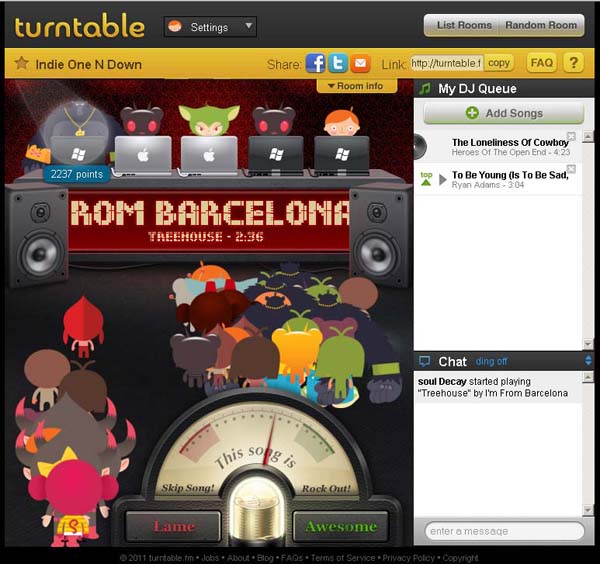
A look inside a Turntable.fm room.
Turntable.fm was fun, but I needed music on demand (for free). The free version of Spotify is only accessible by invitation, so I couldn’t download it right away. I asked Ms. Logue for an invite, to which she obliged, and I began my journey.
Spotify is an on-demand music service that streams music to your desktop or mobile device. There are three levels of membership: Free, Unlimited, and Premium. Free gives access to Spotify’s streaming library with ads between songs (every once in a while); Unlimited is the same but without the ads; Premium allows the same ad-free access to music, and also adds the ability to play user-created playlists when not online and streaming playback on your mobile device. Spotify streams in the Ogg Vorbis format, at three different streaming qualities: Q3/96kbps, Q5/160kbps, and Q9/320kbps. Not all tracks are available in high bit rate streaming; 160kbps is offered for desktop streaming, but Premium users can stream at 320kbps by adjusting their preferences. 96kbps is the default streaming rate for mobile devices, although 160kpbs can be applied by changing options within the mobile app. I downloaded the Free version (160kbps streaming to my Dell desktop) and listened through various headphones, including Grado SR60s, Monster Beats Studios, Polk Audio UltraFit 3000s, and Sennheiser HD428s.
I tested the limits of Spotify’s music library in the dorkiest way possible: filtering through genre using Wikipedia’s “List of Musicians” and selecting, in alphabetical order, those artists with whom I was only somewhat familiar. I started with the following subgenres (to name just a few): alternative country, alternative metal, ambient, anarcho-punk bands, black metal, British blues musicians, Britpop, crooners, and calypso. Artists included Ryan Adams, Alice in Chains, Anti-Flag, Aphex Twin, The Sword, Lightnin’ Hopkins, Jeff Beck, Blur, Cradle of Filth, Tony Bennett, and Harry Belafonte—an eclectic selection of artists from various genres, that I thought would give me an accurate representation of Spotify’s music library. The Lightin’ Hopkins and Harry Belafonte selections both impressed me, featuring full collections of early albums from both artists. Simply by clicking on the record title and hitting Play on the first song, I was able to listen to full albums in sequence, no problem. The first selection to stump Spotify was Jeff Beck’s record Blow by Blow which WAS available on the on-demand music streaming alternative, MOG.
MOG offers similar on-demand services as Spotify, but can also be integrated into your web browser, or be used as a standalone desktop player. MOG streams 320kbps MP3 files, but will decrease the playback rate if the connection is slow or busy. MOG had been recommended to me via by a reader on the Stereophile Facebook page and by cubicle-mate, Stephen Mejias, both sources stating that MOG had more music available. Honestly, it is difficult to judge which music streaming service has the most complete music library. MOG did have Beck’s Blow by Blow but neither Spotify nor MOG had his Live in Japan record with Bogert and Appice. Guess who did? Grooveshark! Alternatively, Spotify did have Harry Belafonte Sings the Blues while MOG did not. Grooveshark only had 4 tracks from this record. Nobody is king.
Another factor to take into consideration: What sort of legal restraints does the artist place on the digital distribution of his or her music? Maybe that is why Spotify, MOG, and Grooveshark do not have Bob Seger’s records.
(Update: I can only guess the reason for this is that Bob Seger has only recently released his catalog on iTunes, and maybe, possibly, there is a lag between this digital release and when it starts appearing on other digital music sites???)
There are a multitude of streaming services out there. This review was certainly just a brief overview of my own experience with the programs. To judge one streaming program against the other is probably unfair. Digital platforms are created to satisfy a need. Grooveshark may provide the easiest access to individual tracks—the interface is accessible without a username or registration. So for quick music on the go, Grooveshark is tits. Slacker and Pandora, two different radio streaming programs which will give you different results, serve two different purposes. Slacker is best for the person who wants to customize their station mostly on the front-end rather than commit to continuous involvement. Pandora encourages constant formatting, which can lead to fruitful results, if you have the patience for it. Spotify and MOG are the most similar of all the programs, but again, it just boils down to preference. Do you want your music-streaming program integrated into your web browser? MOG does this. Would you like to also see your iTunes library within your digital library? Spotify does this. Also, both programs now facilitate sharing songs with your friends on Facebook. Both allow you to custom make playlists. Both at premium service levels allow you to sync playlists for playback when not online. And both are free on the onset, so why not just try both and see what you like best? You can make the most out of any program.
Currently listening to Cradle of Filth’s compilation record Lovecraft and Witch Hearts. One thing is for certain, I would have never listened to Cradle of Filth without these services.

Just dive in! Patagonia, Argentina. Photo: Alberto Bitran.
- Log in or register to post comments




